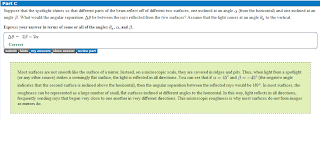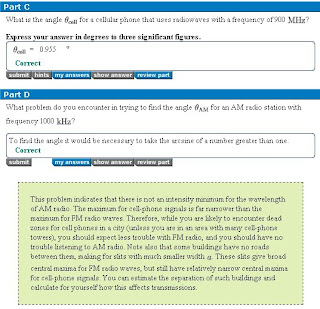Hint #1: This is a silly problem.
Hint #2: More than 1 card can go in a 'slot'.
Wednesday, November 28, 2007
Sunday, November 25, 2007
MP10-1: Resolving pixels on the computer screen (spoiler)
Saturday, November 24, 2007
MP9: Double slit 2 (spoiler)
Thursday, November 22, 2007
MP9: Doorway Diffraction (spoiler)
Happy Thanksgiving to all in Phys 203 (and others)
Hi, I hope all of you have a nice Thanksgiving! - David
Wednesday, November 21, 2007
MP9: Problem 22.36 (solution with explanation)
MP9: Problem 22.18 (solution with explanation)
The key to this problem is the basic diffraction relationship asin (theta) = lambda, where lambda is ( the speed of light 3 * 10^ 8 m/s / the given 800 Mhz Frequency), then you multiply by 180/pi to convert to radians.
However, this gives you only half the angle you need. Recall that for diffraction the 1st minima correspond with m=+/- 1, and the central maximum is everything in between. So you need to multiple the above function by 2.


However, this gives you only half the angle you need. Recall that for diffraction the 1st minima correspond with m=+/- 1, and the central maximum is everything in between. So you need to multiple the above function by 2.


Friday, November 16, 2007
MP8-2: Lights of different wavelengths on a diffraction grating (hints - read this first)
Thursday, November 15, 2007
Wednesday, November 14, 2007
MP8-2: Using a Michelson Interferometer (spoiler)
MP8-2: Single slit diffraction (spoiler)
I found it helpful to convert to micrometers for each individual measurement. Note the "0.5" in the denominator. I need this because the distance to the central point is only half the distance given of 17.9mm. The "3" in the numerator represents m=3 for the third minimum.

For Part B, recall the equation for refraction m1*lambda1=m2*lambda2. Since water has a higher index of refraction than air, the wavelength will become shorter in water as compared with the original. Since the width of the fringes is proportional to lambda, this will make them narrower.


For Part B, recall the equation for refraction m1*lambda1=m2*lambda2. Since water has a higher index of refraction than air, the wavelength will become shorter in water as compared with the original. Since the width of the fringes is proportional to lambda, this will make them narrower.

Tuesday, November 13, 2007
MP8-1: Fringes from different interfering wavelengths (spoiler with explanation)
Hints for this problem: Start with the constructive interference equation, use the small angle approximation (sin x = x) and solve for theta when m=1 (it isn't m=0 because that would be for theta=0 and we know there is an nonzero angle based on the problem description).
The theta will be the same for the destructive scenario, since the destructive band with the second wavelength occurs in the same place as the constructive band for the original wavelength. Use m=0, since this is the first destructive interference band.
Solving this relationship shows you that the second wavelength is twice the first, which you then convert to micrometers.

The theta will be the same for the destructive scenario, since the destructive band with the second wavelength occurs in the same place as the constructive band for the original wavelength. Use m=0, since this is the first destructive interference band.
Solving this relationship shows you that the second wavelength is twice the first, which you then convert to micrometers.

Monday, November 12, 2007
MP8-1: "understanding" Fraunhofer Diffraction
Saturday, November 10, 2007
MP8-1: Problem 22.4 (spoiler)
For this problem use the so-called "small angle approximation" or sin x = tan x = x. So you can replace sin (theta) with just theta in the interference equation, and solve for d, the spacing between the two slits.
I converted all the units to meters initially, and the final 10^3 power is to convert from meters to millimeters.

I converted all the units to meters initially, and the final 10^3 power is to convert from meters to millimeters.

Subscribe to:
Comments (Atom)











































